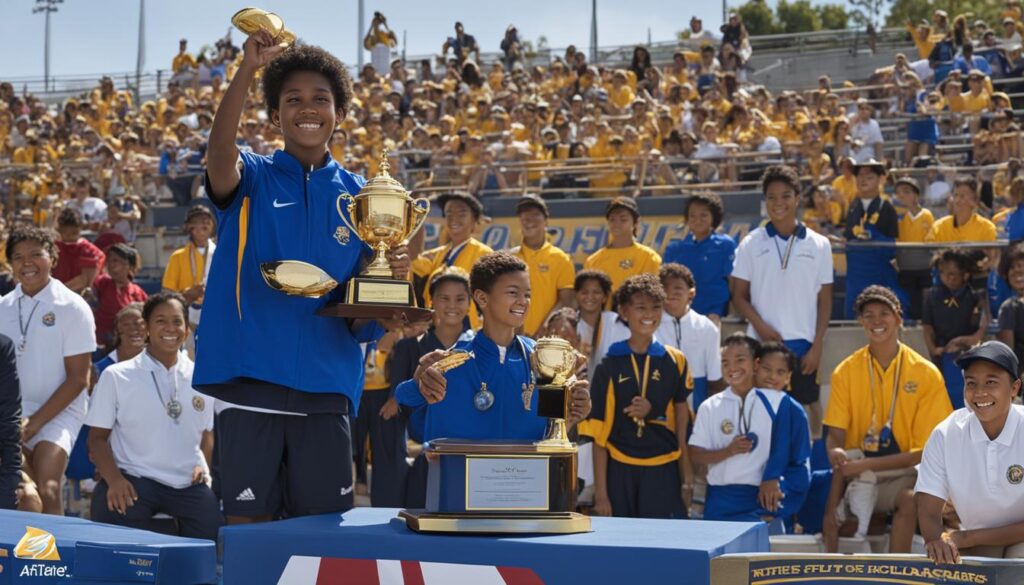Financing a college education as a student-athlete can be challenging. While athletic scholarships provide valuable support, they often don’t cover the full cost of tuition, room, and board. In this section, we will explore the different types of scholarships available for student-athletes, debunk misconceptions surrounding athletic scholarships, and highlight the importance of meeting academic requirements for eligibility.
When it comes to sports funding, navigating the landscape of college athletics can be overwhelming. From the NCAA to sports programs and sports management, there are various factors to consider. Understanding how athletic performance can impact education benefits and the availability of team scholarships is crucial for aspiring college athletes.
Key Takeaways:
- Athletic scholarships may not cover the full cost of tuition, room, and board for college athletes.
- There are different types of scholarships available, including athletic scholarships and academic scholarships.
- Meeting academic requirements is essential for eligibility for athletic scholarships.
- Understanding the NCAA regulations and the divisions that offer athletic scholarships is important.
- Athletic scholarships can be categorized as headcount sports or equivalency sports.
Athletic Scholarships: What You Need to Know
Athletic scholarships play a crucial role in financing a college education for student-athletes. These scholarships are awarded based on the student-athlete’s athletic abilities and how they can contribute to the team. It is important to understand the key aspects of athletic scholarships, including the role of the college athletic department, NCAA regulations, and the different division levels where scholarships are offered.
Colleges and universities that offer athletic scholarships are typically part of the NCAA, with NCAA Division I and Division II schools being the primary sources of athletic grant-in-aid. The National Association of Intercollegiate Athletics (NAIA) and junior colleges also offer athletic scholarships. However, it’s important to note that not all colleges offer athletic scholarships, and some schools in the NCAA Division III focus more on academic scholarships or need-based aid rather than athletically related financial aid.
The number of athletic scholarships available varies by sport and division level. The decision on who receives scholarships is typically made by the coach, considering various factors such as the athlete’s talent, potential contribution to the team’s success, and academic requirements.
To better understand athletic scholarships, let’s take a look at the table below that provides an overview of the scholarship opportunities in different divisions:
| Division | Athletic Scholarships Offered | Academic Scholarships | Need-Based Aid |
|---|---|---|---|
| NCAA Division I | Yes | Varies by school | Varies by school |
| NCAA Division II | Yes | Varies by school | Varies by school |
| NAIA | Yes | Varies by school | Varies by school |
| Junior Colleges | Yes | Varies by school | Varies by school |
The table provides a general overview, but it’s important for student-athletes to research specific schools and their athletic programs to understand the scholarship opportunities available to them.
Understanding the Different Types of Athletic Scholarships
Athletic scholarships can be categorized into two main types: headcount sports and equivalency sports. Each type has its own criteria and implications for student-athletes. Let’s take a closer look at each category:
Headcount sports:
Headcount sports refer to sports where full scholarships are offered to athletes. These scholarships cover the entire cost of tuition, room, and board. Examples of headcount sports include NCAA Division I men’s and women’s basketball and football. In these sports, the number of scholarships available is limited, and only a select few athletes receive this type of scholarship.
Equivalency sports:
Equivalency sports, on the other hand, offer partial scholarships that can be divided among multiple athletes on the team. These scholarships cover a portion of the cost of tuition, room, and board. Examples of equivalency sports include all sports in NCAA Division II and NAIA. The amount of athletic scholarship offered can vary depending on the sport and the importance of the athlete’s role on the team.
It is important for student-athletes to understand the type of scholarship they may be eligible for based on their sport and the division they are competing in. This knowledge can help them navigate the process of applying for scholarships and make informed decisions about their future.
| Type of Scholarship | Sports | Division | Scholarship Coverage |
|---|---|---|---|
| Headcount sports | Men’s and women’s basketball, football | NCAA Division I | Full scholarships |
| Equivalency sports | All sports in NCAA Division II and NAIA | NCAA Division II, NAIA | Partial scholarships |
Understanding the different types of athletic scholarships is crucial for student-athletes who are considering pursuing a college education while continuing their athletic career. It allows them to have realistic expectations and make informed decisions about their college choices and financial planning.
What Expenses Do Athletic Scholarships Cover?
Athletic scholarships can provide significant financial support for student-athletes pursuing a college education. However, it is important to understand what expenses these scholarships cover and what additional costs may need to be accounted for. Let’s take a closer look at the expenses typically covered by athletic scholarships.
Tuition and Fees:
One of the primary expenses that athletic scholarships usually cover is college tuition. This includes the cost of attending classes and any mandatory fees associated with enrollment. It’s important to note that while athletic scholarships may cover tuition, they may not cover all fees, such as laboratory or course-specific fees. It’s essential for student-athletes to be aware of any additional fees they may be responsible for.
Room and Board:
Athletic scholarships often extend to cover the cost of room and board. This includes expenses related to on-campus housing or off-campus living arrangements, as well as meal plans. It’s important for student-athletes to understand the specific terms of their scholarship and whether it includes provisions for room and board. In some cases, scholarships may only cover a portion of these expenses, requiring student-athletes to contribute to the remaining costs.
Direct College Costs vs. Indirect College Costs:
It’s important to differentiate between direct college costs and indirect college costs when considering what expenses athletic scholarships cover. Direct college costs include expenses directly related to education, such as tuition, fees, and room and board. Indirect college costs, on the other hand, refer to expenses that are not directly tied to education but are still necessary for college life. These can include textbooks and supplies, transportation, meals not covered by a meal plan, and insurance premiums.
While athletic scholarships typically cover direct college costs, they may not cover indirect college costs. Student-athletes should be prepared to budget for these additional expenses and consider other financial resources, such as part-time employment or student loans, if necessary.
Balancing Athletic Scholarships and College Expenses
Student-athletes who receive athletic scholarships from NCAA Division I schools have access to additional financial resources through the Student Assistance Fund (SAF). The SAF aims to support student-athletes in managing unforeseen expenses and providing assistance for various needs. These funds can be used for a range of purposes, including summer school, academic course supplies, medical and dental costs, and student-athlete emergencies. Each college determines how the SAF money is distributed among athletes based on their individual needs.
Having access to the Student Assistance Fund can be invaluable for student-athletes, as it helps alleviate the financial burden that may come along with pursuing higher education while participating in sports. Whether it’s the cost of summer school to stay on track with academics or unexpected medical expenses, the SAF provides a safety net for student-athletes to ensure they can fully focus on their athletic and academic commitments without unnecessary financial stress.
It’s essential for student-athletes to be aware of the resources available to them and how to access them when needed. By staying informed about the Student Assistance Fund and taking advantage of financial resources, student-athletes can better navigate their college expenses and ensure they have the necessary support to succeed both on and off the field.

Table: Student Assistance Fund Expenses
| Expense | Description |
|---|---|
| Summer School | Funding for additional academic courses during the summer term |
| Academic Course Supplies | Financial assistance for textbooks, study materials, and other academic resources |
| Medical and Dental Costs | Coverage for necessary medical and dental treatments and procedures |
| Student-Athlete Emergencies | Funding for unforeseen circumstances or emergencies related to the student-athlete’s well-being |
Myths and Realities of College Athletic Scholarships
There are several myths surrounding college athletic scholarships that can often mislead student-athletes and their families. It is important to separate fact from fiction when considering these opportunities. One common misconception is that all athletic scholarships are full-ride scholarships that cover all expenses, including tuition, room, and board. In reality, full-ride scholarships are rare and typically reserved for highly recruited athletes in high-profile sports.
Another myth is that every school offers athletic scholarships. While many colleges and universities do have athletic programs, not all of them have the budget or resources to offer athletic scholarships. It is crucial for student-athletes to research the schools they are interested in and understand the scholarship opportunities available to them.
“Myth: All athletic scholarships are full-ride scholarships. Reality: Full-ride scholarships are rare and typically limited to highly recruited athletes in high-profile sports.”
One misconception that can cause confusion is the idea of verbal commitments. It is important for student-athletes to understand that verbal commitments are not binding agreements. Until a student-athlete signs a National Letter of Intent (NLI), there is no guarantee of an athletic scholarship. Verbal commitments are opportunities for coaches and athletes to express mutual interest, but they are not legally binding.
It is vital for student-athletes and their families to recognize that athletic scholarships are only one piece of the financial aid puzzle. Academic scholarships, need-based grants, and other forms of financial aid can also contribute to the overall funding package. It is crucial to explore all available options and understand the various criteria for eligibility.
Table: The table below provides a summary of common myths and the corresponding realities of college athletic scholarships:
| Myth | Reality |
|---|---|
| All athletic scholarships are full-ride scholarships. | Full-ride scholarships are rare and limited to highly recruited athletes in high-profile sports. |
| Every school offers athletic scholarships. | Not all schools have the budget or resources to offer athletic scholarships. |
| Verbal commitments guarantee an athletic scholarship. | Verbal commitments are not legally binding; a National Letter of Intent must be signed. |
| Athletic scholarships are the only form of financial aid. | Academic scholarships, need-based grants, and other forms of financial aid can also contribute to the funding package. |

Summary
Understanding the realities of college athletic scholarships is crucial for student-athletes and their families. It is important to dispel common myths, such as the belief that all athletic scholarships are full rides or that every school offers athletic scholarships. Verbal commitments should be approached with caution, as they are not legally binding until a National Letter of Intent is signed. Additionally, student-athletes should explore all available financial aid options, including academic scholarships and need-based grants. By debunking these myths and understanding the realities, student-athletes can make informed decisions about their future education and athletic pursuits.
Financial Literacy for College Athletes
Budgeting is an essential skill for college athletes to ensure financial responsibility and manage their expenses. It allows student-athletes to balance their scholarships with other college costs and plan for their financial future. By developing financial literacy and budgeting skills, student-athletes can navigate their athletic and academic journey more confidently.
Creating a budget starts with understanding your income and expenses. Student-athletes should take into account their athletic scholarships, any additional financial aid, and any other sources of income. This information can help determine how much money is available for expenses. It is important to track and categorize expenses, including tuition, textbooks, housing, meals, transportation, and personal expenses. This allows for a comprehensive view of spending patterns and identifies areas where adjustments can be made.
A savings mindset is crucial for college athletes. While it may be tempting to spend money on non-essential items, having a savings mindset can help student-athletes prioritize their financial goals. Setting aside a portion of income for savings can provide a safety net for unexpected expenses and future financial planning. It is recommended to establish an emergency fund to cover unforeseen costs and to save for long-term goals, such as post-graduation expenses or starting a career.
Seeking financial education resources can also be beneficial for student-athletes. Many colleges and universities offer financial literacy programs or workshops tailored to student-athletes. These programs cover topics such as budgeting, debt management, and investing. Taking advantage of these resources can help student-athletes gain a better understanding of personal finance and make informed financial decisions.
| Advantages of Financial Literacy for College Athletes | Disadvantages of Ignoring Financial Responsibility |
|---|---|
|
|
Quote:
“Financial literacy is not only about managing money; it’s about empowering student-athletes to take control of their financial future. By developing budgeting skills and a savings mindset, college athletes can lay the foundation for a successful and secure financial journey.”
In summary, financial literacy is vital for college athletes to make informed financial decisions and manage their expenses effectively. Budgeting, developing a savings mindset, and seeking financial education resources are key steps towards financial responsibility. By prioritizing financial literacy, student-athletes can navigate their athletic and academic journey with confidence and set themselves up for long-term financial success.

Conclusion
Navigating athletic scholarships and finances can be a complex process for student-athletes. Understanding the different types of scholarships available, the expenses they cover, and the myths surrounding them is crucial for success. By combining athletic scholarships, academic scholarships, and financial aid, student-athletes can maximize their opportunities and achieve both their athletic and academic goals.
It is important for student-athletes to develop financial literacy and budgeting skills to manage their college expenses effectively. Budgeting allows them to balance their scholarships with other costs and plan for their financial future. By practicing financial responsibility, student-athletes can avoid unnecessary debt and cultivate a savings mindset for long-term financial goals.
Remember, not every school offers athletic scholarships, and not all athletic scholarships are full rides. Many colleges provide a combination of athletic scholarships, academic scholarships, and financial aid. It’s essential for student-athletes and their families to have a realistic understanding of the opportunities and factors that can affect the availability of athletic scholarships, such as athletic performance and academic standing.
Ultimately, with a solid understanding of athletic scholarships, financial aid options, and effective budgeting skills, student-athletes can navigate their athletic and academic journey with confidence and set the foundation for a successful future.
FAQ
What are athletic scholarships?
Athletic scholarships are financial aid awarded to student-athletes based on their athletic abilities and how they can contribute to the team. They are offered by college athletic departments and are subject to NCAA regulations.
Which colleges offer athletic scholarships?
Not all colleges offer athletic scholarships. Only certain programs at the NCAA Division I, Division II, NAIA, and junior colleges are allowed to offer athletic grant-in-aid. NCAA Division III schools do not offer athletically related financial aid but provide academic scholarships or need-based aid.
How are athletic scholarships awarded?
The decision on who receives athletic scholarships is made by the coach. The number of scholarships available varies by sport and division level.
What is the difference between headcount sports and equivalency sports?
Headcount sports, such as NCAA Division I men’s and women’s basketball and football, offer full scholarships to athletes. Equivalency sports, which include all sports in NCAA Division II and NAIA, offer partial scholarships that can be divided among multiple athletes on the team.
What expenses do athletic scholarships cover?
Athletic scholarships can be applied towards college tuition, registration fees, room and board, and miscellaneous fees such as orientation and technology. However, they may not cover indirect college costs, which include expenses like textbooks, transportation, meals, and insurance premiums.
What financial resources are available to student-athletes?
Student-athletes who receive athletic scholarships from NCAA Division I schools are eligible for additional financial resources through the Student Assistance Fund (SAF). SAF money can be used to cover expenses such as clothing, travel, summer school, academic supplies, medical and dental costs, and student-athlete emergencies.
What are the myths surrounding college athletic scholarships?
Some common myths include the belief that all athletic scholarships are full rides and that every school offers athletic scholarships. In reality, only a portion of student-athletes receive athletic scholarships, and many colleges offer a combination of athletic scholarships, academic scholarships, and financial aid.
How can college athletes develop financial literacy?
College athletes can develop financial literacy by learning about budgeting, financial responsibility, and managing their expenses. This can help them avoid unnecessary debt and plan for their future financial goals.
How Can Athletes Maximize Their Chances of Receiving College Scholarships and Grants?
Athletes can unlock scholarships and grants by excelling in their sport and maintaining high academic performance. Building a strong athletic profile, including participating in competitive events and earning recognition, is essential. Additionally, athletes should focus on developing relationships with their coaches and ensuring they are aware of their goals and aspirations.


Pingback: Money-Smart Students: The Importance of Financial Literacy Courses – Straight Fire Money